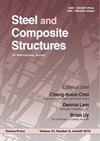Influences of porosity distributions and boundary conditions on mechanical bending response of functionally graded plates resting on Pasternak foundation
IF 3.9
3区 工程技术
Q1 CONSTRUCTION & BUILDING TECHNOLOGY
引用次数: 74
Abstract
In this paper, a higher order shear deformation theory for bending analysis of functionally graded plates resting on Pasternak foundation and under various boundary conditions is exposed. The proposed theory is based on the assumption that porosities can be produced within functionally graded plate which may lead to decline in strength of materials. In this research a novel distribution of porosity according to the thickness of FG plate are supposing. Governing equations of the present theory are derived by employing the virtual work principle, and the closed-form solutions of functionally graded plates have been obtained using Navier solution. Numerical results for deflections and stresses of several types of boundary conditions are presented. The exactitude of the present study is confirmed by comparing the obtained results with those available in the literature. The effects of porosity parameter, slenderness ratio, foundation parameters, power law index and boundary condition types on the deflections and stresses are presented.孔隙率分布和边界条件对帕斯捷尔纳克基础上功能梯度板力学弯曲响应的影响
本文提出了一种适用于不同边界条件下帕斯捷尔纳克地基上功能梯度板弯曲分析的高阶剪切变形理论。所提出的理论是基于这样的假设,即孔隙可以在功能梯度板内产生,这可能导致材料的强度下降。本研究提出了一种新的孔隙率随FG板厚度的分布规律。利用虚功原理推导了该理论的控制方程,并利用Navier解得到了功能梯度板的闭型解。给出了几种边界条件下挠度和应力的数值计算结果。通过将所得结果与文献中的结果进行比较,证实了本研究的准确性。分析了孔隙率参数、长细比、基础参数、幂律指数和边界条件类型对挠度和应力的影响。
本文章由计算机程序翻译,如有差异,请以英文原文为准。
求助全文
约1分钟内获得全文
求助全文
来源期刊

Steel and Composite Structures
工程技术-材料科学:复合
CiteScore
8.50
自引率
19.60%
发文量
0
审稿时长
7.5 months
期刊介绍:
Steel & Composite Structures, An International Journal, provides and excellent publication channel which reports the up-to-date research developments in the steel structures and steel-concrete composite structures, and FRP plated structures from the international steel community. The research results reported in this journal address all the aspects of theoretical and experimental research, including Buckling/Stability, Fatigue/Fracture, Fire Performance, Connections, Frames/Bridges, Plates/Shells, Composite Structural Components, Hybrid Structures, Fabrication/Maintenance, Design Codes, Dynamics/Vibrations, Nonferrous Metal Structures, Non-metalic plates, Analytical Methods.
The Journal specially wishes to bridge the gap between the theoretical developments and practical applications for the benefits of both academic researchers and practicing engineers. In this light, contributions from the practicing engineers are especially welcome.
 求助内容:
求助内容: 应助结果提醒方式:
应助结果提醒方式:


